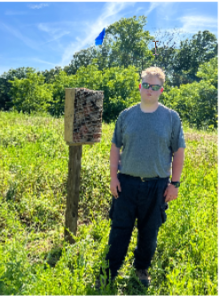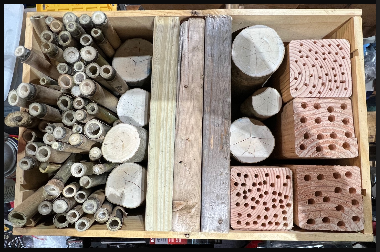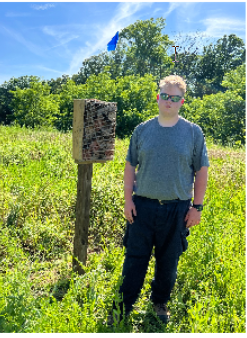 Naval Air Station Patuxent River has long been a steward of the local flora and fauna of the Southern Maryland Landscape since its construction in 1943. With nearly 15,000 acres of land dedicated to the Test mission here, it’s no surprise that much of that land is covered in forest, grassy meadows, and marsh lands that are home to various animals.
Naval Air Station Patuxent River has long been a steward of the local flora and fauna of the Southern Maryland Landscape since its construction in 1943. With nearly 15,000 acres of land dedicated to the Test mission here, it’s no surprise that much of that land is covered in forest, grassy meadows, and marsh lands that are home to various animals.
It was with this in mind that Colin Maupin of Sea Scouts Ship 1942 decided that it would be an ideal location for a series of mason bee houses constructed as part of his Eagle Scout project. Coordinating with the NAS Pax River Natural Resources department and volunteers throughout several organizations, Maupin was able to source materials, construct, and place 10 bee houses in key locations at NAS Patuxent River.
“I spoke to the Environmental Department on base about a project that would help the environment in some way,” said Maupin. “After talking to Rebecca Stump there, we decided bee houses would be a good project because they are important pollinators, and starting to decline in this area due to climate change, pesticide use and parasites. Pollinators like the mason bees sustain our ecosystem and help conserve our natural resources by helping plants reproduce.”
The bee houses are constructed from recycled wood boxes filled with bamboo shoots, wood branches and wood blocks with holes drilled in them for the bees to nest in. Unlike honey bees, the mason bees are more solitary and do not build hives, so the bee houses provide something of an “apartment complex” for the bees to nest in. Leading a team of approximately 20 volunteers from his Sea Scouts ship, Boy Scouts Troop 413, and the Great Mills High School Biology Build group, Maupin set to sourcing materials and constructing the bee houses early in 2022 with a goal of placing them in the ground by early spring.
“I even made contact with some local beekeepers in my area to participate as well,” said Maupin. “We got old boxes and filled them up with bamboo and wood that we cut down on base. Then we drilled different sized holes in the wood – different sized holes for different sized bees – and put it all together with metal chicken wire mesh to keep predators from getting in and eating larva. The bees like a variety of materials to nest in, which is why I included various types of wood.”
Two sites were chosen just up from NAS Patuxent River’s Gate 3 in high grass fields ideal for pollinators such as mason bees. Maupin and his team got to work with Pax River Environmental to dig three-foot post holes to place the boxes at a preferred height of five-feet off the ground.
The project is the third Scouts project the Maupin family has done at Pax River. Colin’s brother Liam constructed bat houses for Pax River in 2021, and their brother Aiden constructed fishing line recycling tubes for fishing locations around base earlier this year.
NAS Patuxent River has a long-standing relationship with civic organizations such as the Boy Scouts and Sea Scouts, and Scouts projects can be found throughout the installation.
“I’m extremely proud of the work our local Scouts have done to preserve the natural resources here at Pax,” said Capt. Derrick Kingsley, NAS Patuxent River commanding officer. “The leadership and dedication shown by the Colin and his brothers is truly admirable, and I hope to see many more projects like theirs here.”




